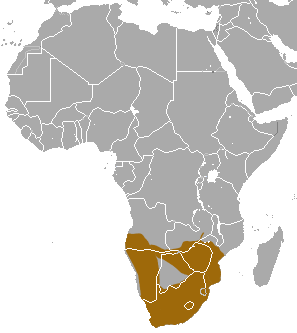Baboon
Baboons are a group of Old World monkeys belonging to the genus Papio, one of the 23 genera of primates. The five species of baboons are some of the largest non-hominoid members of the primate order; only the mandrill and the drill are larger. Baboons are native to the African continent and have been found in various habitats, ranging from savannahs to forests and mountains. They are highly adaptable and are among the world's most recognizable monkeys, known for their robust build, dog-like faces, and large, sharp canines.
Description[edit | edit source]
Baboons typically exhibit sexual dimorphism, with males being significantly larger than females. They have powerful jaws with sharp canine teeth. Their coat color varies depending on the species, from yellowish-brown to dark grey. Baboons have long, muscular tails that can vary in shape depending on the species, but unlike some monkeys, their tails are not prehensile.
Behavior[edit | edit source]
Baboons are terrestrial (ground dwelling) and are found in open savannah, open woodland, and hills across Africa. They have a complex social structure and live in groups called troops. Troop sizes can vary enormously and are composed of males, females, and their offspring. The social dynamics within a troop are intricate, with a clear hierarchy among both males and females. Baboons communicate using a variety of vocalizations, body postures, and facial expressions.
Baboons are omnivorous, feeding on a wide range of food, including fruits, grasses, seeds, roots, and occasionally small animals, including insects and small mammals. Their ability to adapt their diet to the available food sources plays a significant role in their ability to inhabit diverse environments.
Reproduction[edit | edit source]
Female baboons have a gestation period of about six months and typically give birth to a single offspring. The social structure of the troop plays a crucial role in the rearing of young baboons, with females often assisting each other in childcare. The offspring are highly dependent on their mothers for the first few months of life.
Conservation Status[edit | edit source]
The conservation status of baboons varies by species. Some species are abundant and have stable populations, while others face threats from habitat destruction and hunting. Conservation efforts are in place in various regions to protect their natural habitats and regulate hunting.
Species[edit | edit source]
The genus Papio is divided into five species:
- Olive baboon (Papio anubis), found in the savannahs of the Sahara.
- Yellow baboon (Papio cynocephalus), found in eastern Africa.
- Chacma baboon (Papio ursinus), found in southern Africa.
- Guinea baboon (Papio papio), found in western Africa.
- Hamadryas baboon (Papio hamadryas), found in the Horn of Africa and southwestern Arabia.
In Culture[edit | edit source]
Baboons have been present in various cultures throughout history, often symbolizing different things depending on the culture. In ancient Egypt, the baboon was revered and often associated with wisdom and the god Thoth.
Search WikiMD
Ad.Tired of being Overweight? Try W8MD's physician weight loss program.
Semaglutide (Ozempic / Wegovy and Tirzepatide (Mounjaro / Zepbound) available.
Advertise on WikiMD
|
WikiMD's Wellness Encyclopedia |
| Let Food Be Thy Medicine Medicine Thy Food - Hippocrates |
Translate this page: - East Asian
中文,
日本,
한국어,
South Asian
हिन्दी,
தமிழ்,
తెలుగు,
Urdu,
ಕನ್ನಡ,
Southeast Asian
Indonesian,
Vietnamese,
Thai,
မြန်မာဘာသာ,
বাংলা
European
español,
Deutsch,
français,
Greek,
português do Brasil,
polski,
română,
русский,
Nederlands,
norsk,
svenska,
suomi,
Italian
Middle Eastern & African
عربى,
Turkish,
Persian,
Hebrew,
Afrikaans,
isiZulu,
Kiswahili,
Other
Bulgarian,
Hungarian,
Czech,
Swedish,
മലയാളം,
मराठी,
ਪੰਜਾਬੀ,
ગુજરાતી,
Portuguese,
Ukrainian
Medical Disclaimer: WikiMD is not a substitute for professional medical advice. The information on WikiMD is provided as an information resource only, may be incorrect, outdated or misleading, and is not to be used or relied on for any diagnostic or treatment purposes. Please consult your health care provider before making any healthcare decisions or for guidance about a specific medical condition. WikiMD expressly disclaims responsibility, and shall have no liability, for any damages, loss, injury, or liability whatsoever suffered as a result of your reliance on the information contained in this site. By visiting this site you agree to the foregoing terms and conditions, which may from time to time be changed or supplemented by WikiMD. If you do not agree to the foregoing terms and conditions, you should not enter or use this site. See full disclaimer.
Credits:Most images are courtesy of Wikimedia commons, and templates, categories Wikipedia, licensed under CC BY SA or similar.
Contributors: Prab R. Tumpati, MD





